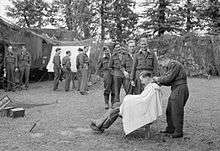No. 65 Squadron RAF
No. 65 Squadron was a squadron of the Royal Air Force.
| No. 65 Squadron | |
|---|---|
| Active | 1 August 1916 (RFC) to 1919 1934–1961 1964–1970 1970–1974 1986–1992 |
| Country | |
| Branch | |
| Motto(s) | Latin: Vi et armis "By force and arms"[1] |
| Battle honours | Western Front, 1917-1918*: Cambrai, 1918*: Somme, 1918*: France & Low Countries*: Dunkirk: Battle of Britain, 1940*: Home Defence, 1940-42: Fortress Europe, 1941-1944*: Channel & North Sea, 1942-1945*: Dieppe: Normandy, 1944: Arnhem: France & Germany, 1944-1945*: Baltic 1945: Honours marked with an asterisk are those emblazoned on the Squadron Standard |
| Insignia | |
| Squadron Badge heraldry | In front of fifteen swords in pile, the hilts in base, a lion passant.[2] The number of swords refers to a memorable combat in which fifteen enemy aircraft were destroyed. |
| Post 1950 Squadron Roundel |  |
First World War
The squadron was first formed at Wyton on 1 August 1916 as a squadron of the Royal Flying Corps with a core provided from the training ground at Norwich. By the end of the First World War, it had claimed over 200 victories. Thirteen aces had served with it, including : John Inglis Gilmour, Joseph White, Maurice Newnham, Thomas Williams, William Harry Bland, Alfred Leitch, Jack Armand Cunningham, Godfrey Brembridge, and George M. Cox.[3] Arthur G. Jones-Williams, who would go on to long-range flight record attempts in 1929, also served in the squadron.
Second World War

The squadron reformed in 1934 at RAF Hornchurch with the Hawker Demon, converting to the Gloster Gauntlet in 1936 and the Gloster Gladiator in 1937.[4] During World War II, the squadron operated Supermarine Spitfires, having converted from Gladiators in 1939. In December 1943, the squadron converted to North American Mustangs. For a period of time their Wing Commander was Reg Grant.[5]
Post war
In 1946, the unit converted to the Spitfire LF.XVIe and then the de Havilland Hornet, the Gloster Meteor F.4 and F.8, then the Hawker Hunter F.6. at RAF Duxford from August 1951 until the squadron disbanded in 1961, and then reformed in 1964 as a surface-to-air missile unit, operating the Bristol Bloodhound. During this period, it was based at RAF Seletar, Singapore, and it disbanded again in 1970. From 1970, No. 65 Squadron became the reserve squadron number for No. 226 Operational Conversion Unit RAF at RAF Coltishall, until its disbandment in the mid 1970s. It was thereafter the reserve squadron number of No. 229 Operational Conversion Unit RAF at RAF Coningsby. It was last disbanded at RAF Coningsby in June 1992, by re-numbering as No. 56 (Reserve) Squadron, after serving as the Operational conversion unit for the Panavia Tornado F.2 and F.3 fighter, with the alternative identity of No. 229 OCU.
References
Citations
- Pine, L.G. (1983). A dictionary of mottoes (1 ed.). London: Routledge & Kegan Paul. p. 250. ISBN 0-7100-9339-X.
- Poulsen, C M, ed. (2 September 1937). "RAF Unit Badges". Flight International. 32 (1, 497): 235. ISSN 0015-3710.
- http://www.theaerodrome.com/services/gbritain/rfc/65.php Retrieved 15 May 2011.
- Gustavsson, Håkan. "Gloster Gladiator in 65 RAF Squadron service". Biplane Fighter Aces from the Second World War. Retrieved 17 April 2013.
- Wing Commander Reginald Joseph Cowan Grant Archived 25 May 2010 at the Wayback Machine. New Zealand Fighter Pilots Museum. Retrieved 2011-05-18.
Bibliography
- Jefford, C.G. RAF Squadrons, a Comprehensive Record of the Movement and Equipment of all RAF Squadrons and their Antecedents since 1912. Shrewsbury: Airlife Publishing, 1998 (second edition 2001). ISBN 1-84037-141-2.
External links
| Wikimedia Commons has media related to No. 65 Squadron RAF. |